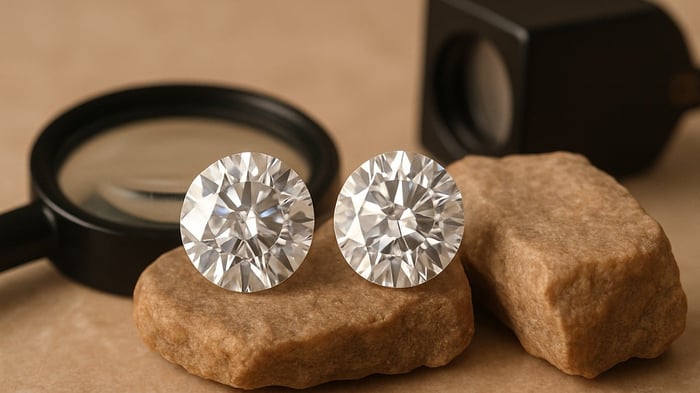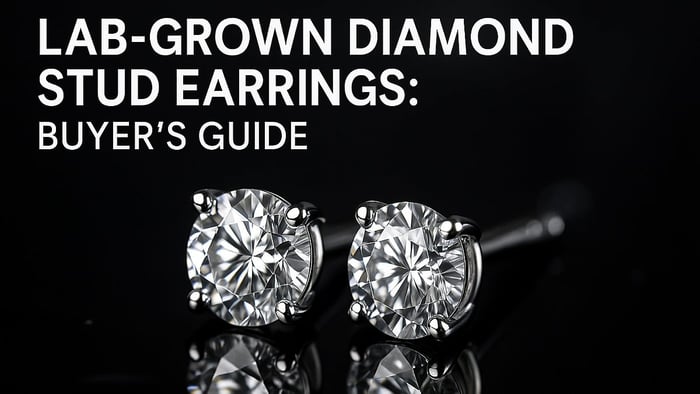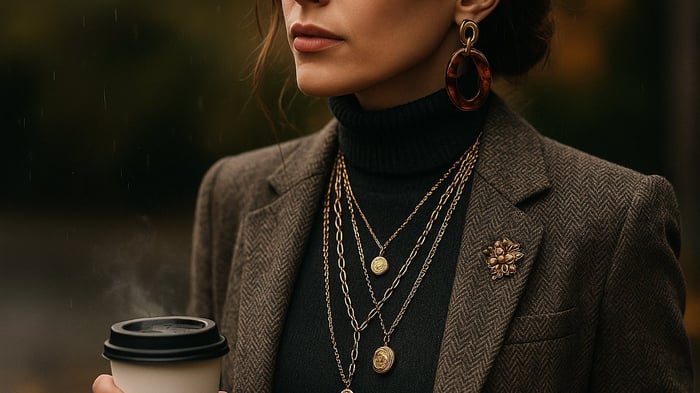In This Article
- Spotting the Difference: Five Ways to Spot Lab-Grown and Natural Diamonds
- The Grader’s Truth: Reports & Paper Trails
- Browse Our Real Diamond RingsMicroscopes & Microprints: The Hidden Language of Inscriptions
- The Price Tag Paradox: Bargain or Blunder?
- Let’s Get Scientific: UV Screening and Spectrometer Stories
- One for Luck: Customisation, Craft, and Wild Cards
Spotting the Difference: Five Ways to Spot Lab-Grown and Natural Diamonds
A few years back, I caught myself peering at two dazzling stones in a shop window, absolutely convinced I could tell them apart. The reality? I couldn’t have been more wrong. Turns out, spotting the difference between lab-grown diamonds and natural ones isn't child's play; it's more like unravelling a tiny, sparkling mystery. Today, I'm taking you beyond the surface, sharing five surprising clues (and a wild anecdote or two) to become a savvier diamond detective.
TL;DR: Lab-grown and natural diamonds appear identical, but a handful of subtle clues; grade reports, inscriptions, pricing oddities, UV quirks, and rare test results, can show you what’s really glittering on your finger.
The Grader’s Truth: Reports & Paper Trails
When it comes to diamonds—whether lab-grown or natural—your best mate for certainty is a reliable Diamond Grading Report. This document is your guarantee, spelling out exactly what you’re buying. In fact, many buyers, burned by flashy promises, have learnt the hard way that a grading report is the only thing they trust.
Certification from trusted third-party labs, such as GIA (Gemological Institute of America) or IGI (International Gemological Institute), is the gold standard. These reports do more than just list the diamond’s stats; they clearly state the diamond’s origin, marking it as either lab-grown or natural. There’s no room for confusion or clever wording. As one expert puts it:
There should be no ambiguity here because natural and lab grown diamonds, they’re graded using the same four C’s criteria.
Lab Diamond 0.50ct Cluster Ring D/VVS Quality in 9k Yellow Gold

£407.00
£915.00
Revel in the striking beauty of the Lab Diamond 0.50ct Cluster Ring, a masterpiece of feminine elegance and sparkle. This exquisite ring features a dazzling cluster of real diamonds, meticulously claw set to showcase their brilliance. Crafted in 9k yellow… read more
Both types of diamonds are assessed using the identical 4Cs:
- Cut
- Colour
- Clarity
- Carat Weight
But the crucial difference is always spelled out in the report. The grading report will state, in plain language, whether the diamond is Lab Grown or Natural. This is not just a technicality—it’s a legal and ethical requirement for all reputable jewellers, including Vanessa Nicole Jewels. The standards are identical, but the distinction is always clear.
So, when you’re comparing diamonds, don’t just rely on what you see or what you’re told. Always ask for the Diamond Grading Report from a respected lab like GIA or IGI. This paper trail is your proof and peace of mind, ensuring you know exactly what sits in your jewellery box.
Browse Our Real Diamond RingsMicroscopes & Microprints: The Hidden Language of Inscriptions
When it comes to Diamond Identification, the real secrets are often hidden in plain sight—right along the diamond’s outer edge, known as the girdle. If you’ve ever watched a jeweller squint through a loupe or hold a magnifying glass over a sparkling stone, you’ve witnessed the industry’s favourite trick for spotting a clever fake. As one expert puts it:
'Holding a magnifying glass over the widest part of a diamond, which is called the girdle, often there is an inscription there.'Most Lab Grown Diamonds feature a microscopic Diamond Inscription on their girdle. TThe micro-engraved markings are imperceptible without magnification.Typically, you’ll spot an ‘LG’ or the words ‘Laboratory Grown’, followed by a unique report number. This number is the diamond’s fingerprint, linking it directly to its grading report.
Alongside these details, you’ll often see the initials of the grading laboratory—such as GIA (Gemological Institute of America) or IGI (International Gemological Institute). These initials are your assurance that the diamond has been professionally assessed, and the inscription matches the paperwork provided at purchase. This closes the loop for both buyers and sellers, making Diamond Identification straightforward and reliable.
- What to look for: ‘LG’ or ‘Laboratory Grown’, a unique report number, and grading lab initials (GIA, IGI).
- Where to look: The girdle—the diamond’s widest edge.
- How to check: Use a jeweller’s loupe or magnifying glass for best results.
Inscription checking has become a bit of an industry in-joke—pros love to see who can spot the tiniest microprint first. I once squinted at a friend’s new ring and, sure enough, the tiniest initials on the girdle solved the riddle of its origin. These micro-engraved details are more than just marks; they are the hidden language that unlocks a diamond’s story, confirming both its authenticity and its journey from lab or earth to your hand.
Nancy Lab Diamond Halo Pear Engagement Ring 1.50ct G/VS in 18k White Gold

£1,465.00
£2,681.00
In the elegance of this Nancy Lab Diamond Halo Pear Engagement Ring, love is perfectly portrayed. Handcrafted in 18k white gold, this ring features a beautiful 1.50ct total weight of G/VS-graded diamonds. The stunning pear-shaped diamond at the centre is… read more
The Price Tag Paradox: Bargain or Blunder?
Picture this: you’re scrolling through a diamond pricing guide and spot a 3-carat, colourless diamond ring for just £12,000. Before you celebrate your savvy shopping, pause and look closer at the fine print. In today’s market, Lab Grown Diamonds have dramatically reshaped pricing, often costing 40–70% less than their natural counterparts. If a price seems too good to be true, it almost certainly is.
Let’s break it down. A 3-carat, colourless, VVS quality Natural Diamond would cost well over £15,000—often much more. As one expert puts it:
‘You’re not going to find a 3-carat natural diamond in colourless VVS quality for £15,000.’So, when you see a dazzling, large diamond at a suspiciously low price, it’s a classic red flag. The Diamond Origin is likely laboratory grown, not natural. This is a key point in any Diamond Pricing Guide: Lab-grown diamonds are far more affordable, but sellers don’t always make the distinction obvious. Some listings may bury the lab-grown label in the details, hoping buyers focus on the price and not the origin.
Here’s a real-world example: One client nearly snapped up what looked like a ‘bargain’ 2-carat ring online. The price was incredible, but a closer look at the listing revealed it was lab-grown—not natural. That’s an awkward moment no one wants after making a big purchase.
- Lab-grown diamonds typically cost a fraction of natural stones.
- If the price is dramatically lower than expected, check the Diamond Origin.
- Always read the listing carefully—genuine, well-priced diamonds should clearly state if they are lab-grown or natural.
The bottom line? In the world of diamonds, price is more than a number—it’s a clue. Use it as your first filter when comparing Diamond Quality and origin. If you’re unsure, consult a trusted Diamond Pricing Guide or ask the seller directly about the diamond’s origin.
Maya Lab Diamond Bezel Solitaire Engagement Ring 2.00ct G/VS Platinum

£1,455.00
£3,806.00
Elevate your love with the Maya Lab Diamond Bezel Solitaire Engagement Ring, handcrafted in the UK. This stunning ring features a round, 2.00 carat G/VS-graded lab-grown diamond, bezel-set in platinum. IGI certified and UK hallmarked, this elegant ring comes with… read more
Let’s Get Scientific: UV Screening and Spectrometer Stories
When it comes to diamond testing methods, jewellers are getting hands-on with science. If you’ve ever seen a jeweller whip out a UV torch in the back room, you know the excitement: everyone gathers round, waiting to see if the diamond glows blue or stays mysteriously dull. This is UV screening diamonds in action—a quick, affordable way to spot differences between natural and laboratory grown diamonds.
Here’s the trick: natural diamonds contain traces of boron, while lab-grown diamonds do not. When you shine a UV light on a natural diamond, the boron atoms get excited and emit a blue glow—this is called fluorescence. If your stone glows blue, you’re likely holding a natural diamond. In contrast, laboratory grown diamonds might show a weak red, yellow, or green glow, or sometimes nothing at all. No lab-grown diamond will fluoresce blue under UV light. This feature is a quirky but reliable indicator; however, not every natural diamond will fluoresce blue—just remember, if a diamond does fluoresce blue, it is definitely natural.
- Natural Diamonds: Blue fluorescence under UV (thanks to boron).
- Lab Grown Diamonds: Red, yellow, green, or no glow at all.
For a deeper dive, jewellers turn to infrared spectrometer testing. This method checks if a diamond is a Type 2A diamond. Here’s the science: 100% of laboratory-grown diamonds are Type 2A, meaning they’re chemically very pure. Only about 2% of natural diamonds fall into this rare category. So, if your diamond is Type 2A, it’s a strong indicator it could be lab-grown, but it’s not definitive proof. Fluorescence is a screening check, so further lab analysis may be needed for a final answer.
Natural diamonds contain traces of boron, while lab grown diamonds do not.As laboratory-grown diamonds become more popular, expect to see more UV screening and infrared spectrometer testing in jewellers’ toolkits. These scientific methods offer quick, affordable clues to a diamond’s origin—sometimes with a little crowd-pleasing drama in the back room.
20 Stone Lab Diamond Full Eternity Ring 2.00ct D/VVS in 18k Rose Gold

£1,387.00
£2,795.00
Indulge in the elegance of the 20 Stone Lab Diamond Full Eternity Ring, an epitome of luxury and opulence. This exquisite ring features 2.00ct of ethical, round-shaped lab diamonds, meticulously set in a claw setting that ensures each stone's brilliance… read more
One for Luck: Customisation, Craft, and Wild Cards
When it comes to choosing between lab-grown diamonds and natural diamonds, the real magic lies not just in the science but in the story you create. Customised diamond jewellery provides you with the opportunity to create something uniquely personal, whether you are attracted to the ethical innovation of lab-grown stones or the timeless allure of natural diamonds. Ultimately, it’s your journey, your values, and your memories that shape the piece, far beyond the technical details of origin.
Modern buyers are increasingly prioritising ethical diamond sourcing and genuine craftsmanship.
‘No matter what type of diamond you choose, the setting is will be made with first-rate British craftsmanship.’This commitment ensures that, whether your diamond is lab-grown or natural, your ring is crafted with care, skill, and meaning—right down to the last detail.
What sets custom rings apart is the opportunity to infuse your story into every element. From the initial consultation to the final polish, you’re involved in every step. This personal journey is supported by expert guidance, especially from jewellers like After Diamonds, who are passionate about exceeding your expectations and making the process as transparent as possible. Your bespoke piece inherently incorporates ethical sourcing. Chat with us using the chat window on every page to discover how we can get you on the right track to create a piece of custom jewellery. You could commission a piece of your (and her) dreams—a piece of jewellery that nobody else will ever own.
Maya Lab Diamond Bezel Solitaire Engagement Ring 4.00ct D/VVS 18k Yellow Gold

£2,690.00
£18,041.00
Celebrate your love with the luxurious Maya Lab Diamond Bezel Solitaire Engagement Ring. This exquisite ring features a 4.00 carat D/VVS-graded lab-created diamond, bezel-set in 18k yellow gold. This ring is certified by IGI and UK hallmarked, with a round… read more
And for a touch of whimsy, imagine a reality show, let's call it Diamond Detectives UK, where couples attempt to guess their diamond’s origin live on TV. Spoiler: most can’t tell the difference, and the awkward close-ups only add to the fun. It’s a reminder that, in the end, the real value of your ring is the meaning you give it, not just its geological backstory.
So, whether you choose a lab-grown or natural diamond, remember: the heart of your real diamond ring is your story, brought to life through ethical sourcing, expert craft, and a little bit of luck.
Browse Our Real Diamond Rings






